 Importance of Social Space in Self-built and Donated Post-disaster Housing
after Java Earthquake 2006
Importance of Social Space in Self-built and Donated Post-disaster Housing
after Java Earthquake 2006 |
| <Asian Journal of Environment-Behaviour Studies (ajE-Bs), 3(6) Jan / Feb 2018 (p.111-119)> |
|
Syam Rachma Marcillia, Ryuzo Ohno
|
Housing reconstruction cases without cultural sensitivity had resulted in rejection.
These raise challenges to understand the importance of cultural background and how it affects residents’ lifestyles. This study investigated self-built
and donated housing through on- field research with questionnaires, interviews, and field observations. Items related to dwelling usage, behaviour adjustments,
evaluation and community activities participation were obtained. Results suggest that residents adjust their physical behavioural aspects to maintain previous
social behaviour lifestyles, though evaluations indicate dissatisfaction with the unchangeable donated housing design. Social interactions importance, flexibility
and open-ended design in housing are advantageous for their post-disaster recovery.
Full paper ⇒ Online |
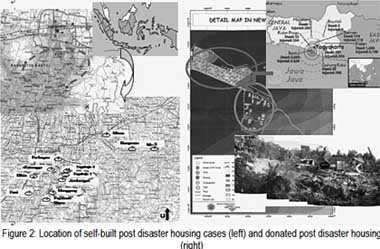 |
 Influence of residents’ cognition of their local environment on evacuation behavior from tsunamis: A case study of Onjuku, Chiba prefecture
Influence of residents’ cognition of their local environment on evacuation behavior from tsunamis: A case study of Onjuku, Chiba prefecture |
| <Japan Architectural Review, Vol. 1, Issue 4, 486-503, June 2018> |
|
Teruyuki Isagawa & Ryuzo Ohno
|
This paper focuses on the effects of residents’ cognition of their local environment on evacuation behavior in the event of a tsunami.
We conducted questionnaire surveys and a sketch map survey in the coastal area of Onjuku, Chiba Prefecture. The results revealed the following: (i) evacuation implementation was influenced by cognition of the
terrain around their home (the elevation from sea level and/or the distance from the sea) although it was not always correct; (ii) although reasons for choosing evacuation place were different from place to
place, main reasons were the location (proximity and ground height) and the sense of safety; and (iii) some improper evacuation route choices (approached the sea, crossed rivers or decreased in elevation) were
caused by “distorted” cognitive maps. These results suggest that understanding residents’ cognition is important in developing effective mitigation measures against tsunamis. The tsunami evacuation planning
should include informing residents of the actual structure of the town and the appropriate direction for evacuation.
Full paper ⇒ Online |
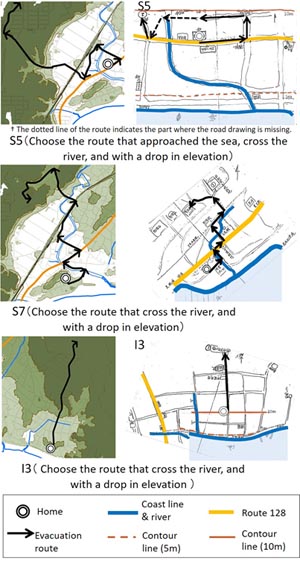 |
 A GIS-base exploration of the relationships between open space systems and urban form for the adaptive capacity of cities after an earthquake:
the cases of two Chilean cities
A GIS-base exploration of the relationships between open space systems and urban form for the adaptive capacity of cities after an earthquake:
the cases of two Chilean cities |
| <Applied Geography, Elsevier, Volume 48, pp. 64-78, Mar. 2014> |
|
Paula Villagra, Carolina Rojas, Ryuzo Ohno, Xue Ma, Karina Gomez
|
In human environments subjected to natural hazards, places such as plazas, parks and free areas can, after a catastrophe,
be places for refuge which can satisfy survival needs and support adaptation. The relationships of such an open space system and the urban form, are explored in this study by focussing on the spatial
context of two Chilean cities affected by earthquakes. Data was collected in interviews with people from emergency organisations using the Projecting Mapping Technique, and subjected to Content and
Geographic Information System analyses to identify the type, utility and distribution of the open space system for earthquake recovery. The objective was to evaluate, by means of different spatial indexes,
the extent the open space system of these cities impact on measures associated with urban resilience, namely overlap in governance and diversity. Findings suggest that the regularity of the grid and city
density affect the adaptive capacity of cities, hence, resilience. Findings also shed light on a methodological approach, including participatory and geographical data, through which these resilient aspects
can be explored and evaluated in other human environments prone to earthquakes.
Full paper ⇒ Online |
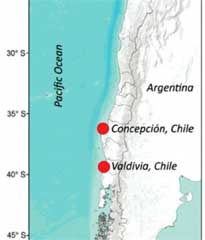 |
 Resident's Behavior in a Potential Area for Tsunami Disaster after the Great East Japan Earthquake
Resident's Behavior in a Potential Area for Tsunami Disaster after the Great East Japan Earthquake
|
| <International Association for People-Environment Studies, Human Experience in the Natural and Built Environment (IAPS22 conference Abstract), p. 180, Jun. 2012.> |
|
Teruyuki Isagawa, Ryuzo Ohno
|
| On March 11, 2011, Japan was hit by the Great East Japan Earthquake that caused massive tsunami along the shore of Tohoku to Kanto region and brought serious damage. More than 15,000 people were killed. Since the delay of evacuation had caused many victims, importance of the behaviour studies in field of disaster prevention measurement has been recognized. To understand how coastal residents made decision and how they behaved at urgent situation become important because this knowledge will aid in the reconsideration of effective announcement in case of emergency and disaster education. Right after the earthquake, meteorological agency gave a large-scale tsunami warning including the coast area of Onjuku town, Chiba prefecture where the local government also issued an evacuation counsel to coastal residents.
In this study, we distributed to all households in the coastal area of Onjuku town, totally 2,272 questionnaire forms. We asked to respond only who were in the town at the time of the earthquake. The questionnaire asked about their behaviour in the form of flowchart and mapping with which we can identify where they were at the time of the earthquake and trace how they behaved after that as well as the reason of their choice such as knowledge and information used. With these, we aim to clarify the influential factors on their decision-making and path choice. From the data, 451 responses (collection rate: 19.8%), we analysed residents behavioural patterns. As a result, respondents acquired information from various source, while the degree of influence on decision-making varied with what type of information and how they received. Behavioural patterns are different according to the location and situation at the time of earthquake. At the same time, we found some risky behaviours made by the residents; some people came back to the home near the sea and others went to the seaside to watch tsunami. |
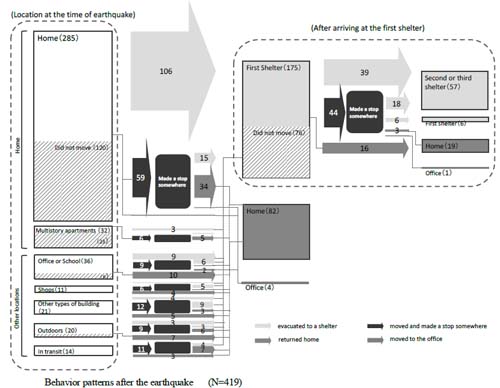 |
 Residents' Usage, Adjustment and Evaluateion of Donated Post-Disaster Housing
Residents' Usage, Adjustment and Evaluateion of Donated Post-Disaster Housing |
| <IAPS post-conference book: Vulnerability, Risks, and Complexity: Impacts of Global Change on Human Habitats, Hogrefe, pp. 67-78, 2012.> |
|
Rachma Marcillia Syam, Ryuzo Ohno
|
Natural disasters physically, psychologically, economically, and socially impact survivors, especially if they are forced to relocate.
Such drastic environmental transitions require adaptation and adjustment.
To understand its influence to residents’ lifestyle, how residents use and evaluate donated post-disaster housing was investigated by a comprehensive survey using questionnaires, in-depth interviews, and observations.
Items related to house conditions and usage, residents’ evaluation, and participation in community activities were analyzed. The results suggest a discrepancy between design with actual usage, and cognition.
Moreover, evaluations indicate a dissatisfaction with fixed aspects of the house design and outdoor spaces. Although certain behaviors are impeded, residents have adapted and adjusted to retain prior lifestyles.
This study shows that facilitating social interactions and flexible, open-ended design are vital for survivors to transition to a new environment.
Full paper → PDF
|
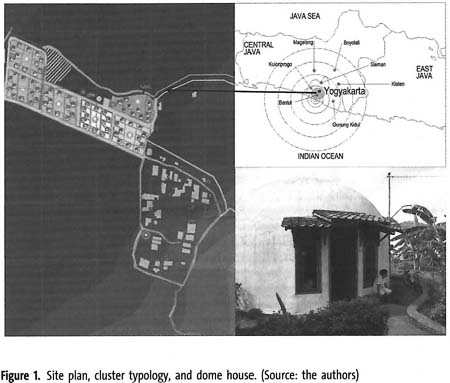
|
 DEVELOPMENT OF A METHOD TO MEASURE OUTDOOR SPACE USING AN AUTOCAD APPLICATION(DEVELOPMENT OF A METHOD TO MEASURE OUTDOOR SPACE USING AN AUTOCAD APPLICATION)
DEVELOPMENT OF A METHOD TO MEASURE OUTDOOR SPACE USING AN AUTOCAD APPLICATION(DEVELOPMENT OF A METHOD TO MEASURE OUTDOOR SPACE USING AN AUTOCAD APPLICATION) |
| <AIJ J. Technol. Des. Vol. 19, No.43, 1085-1089, Oct., 2013> |
|
Xue Ma, Ryuzo Ohno
|
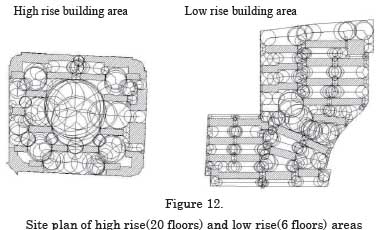
|
The spaces between buildings play various important roles in the residential environment. To describe and analyze the characteristics of these spaces,
present paper developed a program using an AutoCAD application, which measures their lengths and widths automatically. Although this method serves as a criterion
applicable to various aspects of evaluations, herein it is employed to evaluate vulnerabilities of residential areas against earthquake disaster.
Full paper ⇒ Online |
 Towards Earthquake Resistant Residential Neighborhood in China: Examination of Vulnerability in Outdoor Spaces
Towards Earthquake Resistant Residential Neighborhood in China: Examination of Vulnerability in Outdoor Spaces |
| <Asian Journal of Environment- Behaviour Studies, Volume 4, Number 11, pp. 1-7, Jan. 2013> |
|
Xue Ma, Ryuzo Ohno
|
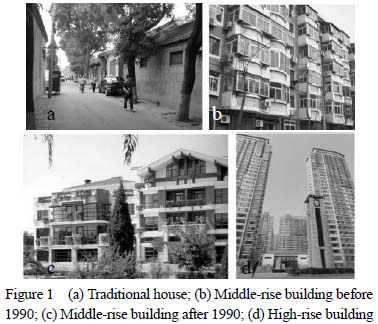
 
Full paper → PDF |
China is a seismically active country. Over the past decades, we have witnessed
growing threats to the living environment by natural disaster. Since the
beginning of the 20th century, China had nearly 800 quakes over 6.0 on
the Richter scale and costing a large number of fatalities and losses.
Disaster mitigation and prevention have been major concerns especially
after the 2008 Sichuan earthquake.
The key issue of the disaster mitigation system is the safety of residential
settlements in urban environment. As China's economy develops at a rapid
pace, urbanization has sped up, urban fabric of its cities is becoming
more and more intricate. In most Chinese cities, the population distribution
within residential areas is quite dense and concentrated. Since many residential
structures are fireproof, the main dangers posed by an earthquake are building
collapse and falling debris. Both present crucial challenges for evacuation
and refuge.
The layout of Chinese city is mostly divided into superblocks with wide avenues, and residential area especially the new ones are more likely to be enclosed.
Although refuge to those avenues is recognized as a safe evacuation route, it may not be reached directly because of the difficulties such us:
the massive scale superblocks, the accessibility and all other restriction of the superblock.
Therefore when the earthquake comes, the important role of open spaces within the superblock which act as a direct evacuation area are needed to be considered.
This research focuses circulation spaces of the urban residential environment.
Field survey of different types of residential areas in the Chinese city of Tianjin is conducted.
Based on survey observations of the outdoor spatial arrangement and details of buildings and environment, developing a computer program to evaluate the different spatial characteristics,
we can figure out disadvantages or advantages and earthquake vulnerabilities of each location by the criterion of circulation spaces.
An open-space network diagram is generated by spatial sequence which indicates the connections between differently scaled open spaces and circulation routes.
Areas with disadvantages and advantages for evacuation of optimization are identified based on the network diagram and analysis results,
as well as several proposals for improvements are brought forward and compared.
|
 An analysis of residents’ responses to the 2006
Central Java Earthquake
An analysis of residents’ responses to the 2006
Central Java Earthquake
|
| <8th Pacific Conference on Earthquake Engineering, Singapore, Paper No. 192, Dec.,2007> |
|
Ryuzo Ohno & Rachma Marcillia Syam
|
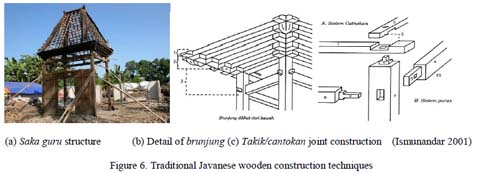
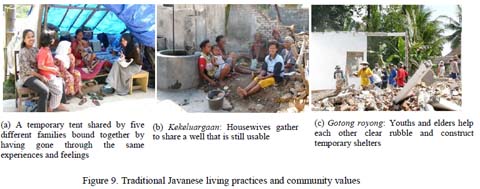 |
Through analysis of questionnaires and one-on-one interviews, this study assesses the physical and sociobehavioral
states of people affected by the earthquake measuring Mw 6.3 that struck the Indonesian island of Java near Yogyakarta on 27 May 2006 at 5:53
AM local time, leaving tremendous damage in the lives of the residents. Data collection for the study was carried out in October and November
2006 as an integrated continuation of a previous session conducted in June. The present survey found (1) that although traditional wooden
houses performed seismically better than brick houses, residents continue to prefer using brick masonry to rebuild their homes because of
their persistent good image of it, (2) that traditional living practices and community values such as gotong royong play quite important
roles in the reconstruction process, and (3) that access to information regarding disaster prevention and mitigation had been lacking in
the community prior to the earthquake. The overview of results provided in this report will prove useful in developing relief programs
and precautionary measures for future disasters.
Full paper → PDF file
|
 DEVELOPMENT OF A PORTABLE VIRTUAL-REALITY SYSTEM FOR DISASTER EDUCATION
DEVELOPMENT OF A PORTABLE VIRTUAL-REALITY SYSTEM FOR DISASTER EDUCATION
|
| <8th eaea-Conference in Moskow, September 2007> |
|
R. Ohno and J. Ryu
|
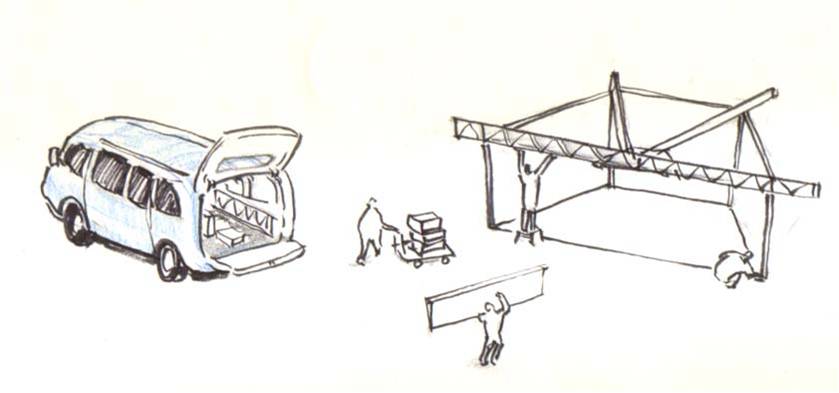 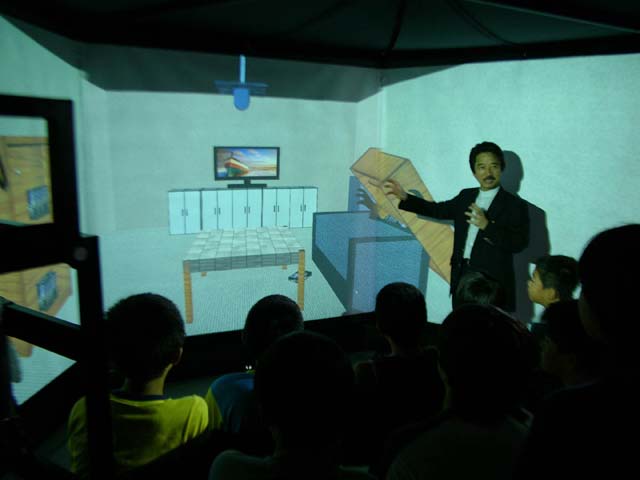 |
We have designed and created a portable immersive
virtual-reality system that enables people to have disaster education without
going to the remote disaster education facilities. The system is composed of
three sets of projector and screen, which can show a wide view image with the
size of 6.0M (width) x 1.8M (height).
This system can display both the real-timely generated computer graphics
and moving picture on the screen. To make this system portable we carefully
designed the size and weight of the parts as well as simplicity of the
frame structure, electrical connections. The easiness of assembling and
disassembling parts and compactness for transportation were essential design
criteria of the system.
As effective disaster education contents, we have developed a program for
the users to examine safety of their own room using virtual-reality technology.
The program helps people reconsider the arrangement of furniture by demonstrating
real-time physics simulation of objects’ behavior in the immersive virtual-reality
system. The expected advantages of this interactive program for disaster
education are: (1) people can have a virtual experience of disaster situation
with higher sense of presence, (2) people can imagine and recognize the
risk of future earthquake, and (3) people can take effective measures to
mitigate the disaster.
Full paper → PDF file
|
| Perception of Earthquake Hazard by Urban Children |
| <Proceedings of Second International Conference on Urban Earthquake Engineering, pp. 338-345, Mar. 2005> |
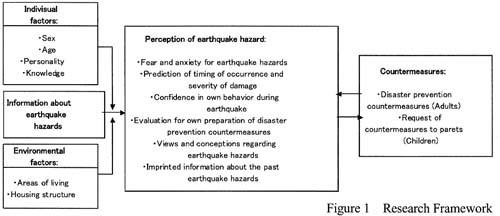 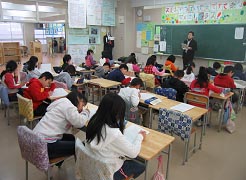 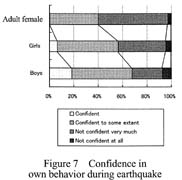 |
|
Megumi Katayama, Ryuzo Ohno, Masashi Soeda, Sima Nara
|
The purpose of this study is to investigate how children perceive earthquake
hazard, especially focusing on the influence of their image toward earthquakes,
knowledge of activities that can reduce the damages.
The survey was conducted with primary school children and their parents.
As results following influential factors are revealed. Age: Children tend
to perceive risks and damages of earthquake hazards more serious than adults,
however they are more optimistic about confidence in own behavior during
earthquake and satisfied with their parents’ preparedness at their home.
Girls pay more attention to the physical damage while adult females concern
more about the sufferers’ post-disaster living conditions. Gender: Girls
have lesser confidence in own behavior during earthquake, and evaluate their
parents’ preparedness lower than boys. Housing structure: People living
in wooden houses anticipate the damage severer than those in other types
of houses. Area of living: Adults in Akashi city anticipate the probability
of a grate earthquake occurrence lower than those in Yokohama city, and
this may suggest that an earthquake experience has an effect to pay less
attention to its occurrence. Communication at home: Children who do not
talk with their parents about disaster prevention seem to feel helpless
and have passive attitude to the earthquake hazard.
Full paper → PDF file |
|
|
TOPへ
|